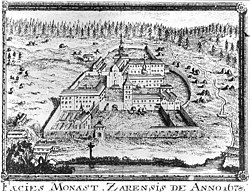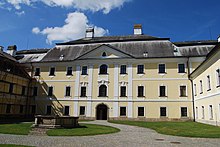Žďár Monastery
| Žzár Cistercian Abbey | |
|---|---|

|
|
| location |
|
| Coordinates: | 49 ° 34 '59 " N , 15 ° 56' 14" E |
| Serial number according to Janauschek |
648 |
| Patronage | Fons Beatae Mariae Virginis |
| founding year | 1252 |
| Year of dissolution / annulment |
1784 |
| Mother monastery | Nepomuk Monastery |
The former Cistercian monastery Žďár (German monastery Saar ) is located in the area of the town Žďár nad Sázavou in Moravia . It was consecrated in honor of "Fons Beatae Mariae Virginis" ( Studnice Blahoslavené Panny Marie ) and existed with interruptions from 1252 to 1784.
geography
The monastery complex is located two kilometers north of the city center of Žďár nad Sázavou at the confluence of the Stržský potok with the Sázava . It is surrounded by two larger ponds; east - Potok on Stržský - the Konventský rybník ( Convention pond ) to the west - on the Sázava - the Branský rybník ( Torteich ). The historical border with Bohemia runs north .
history
The Žďár monastery was founded in 1252 by Boček from Jaroslavice and Zbraslav and settled with monks from the Nepomuk monastery . It was one of the most important monasteries in the Bohemian lands and was promoted by both Boček's descendants and the Bohemian royal family. The history of the formation of the monastery was written around 1300 by the former Saar monk Jindřich / Heinrich Řezbář in 1162, partly rhymed, verses under the title "Cronica domus Sarensis".
In 1353 King Charles IV confirmed the privileges granted by King Wenceslaus I to his son Wenceslaus in 1411 . In 1422 the Hussites burned the monastery down. It was renewed during the reign of King George of Podebrady , who also descended from the Kunstadt family. In 1462 Pope Pius II granted the pontificals .
In 1588, Duke Karl II. , Duke of Münsterberg , to whom the patronage of the monastery from Kunstädter passed and who was a great-grandson of Georg von Podebrads, exchanged the monastic possessions with the Olomouc bishop Stanislaus Pavlovský von Pavlovitz for smaller properties near Sternberg . This made the monastery subject. In 1606, Bishop Franz Seraph von Dietrichstein incorporated the village of Saar into the episcopal estates and one year later elevated it to town. For economic reasons, the monastery was dissolved in 1613. The abbey was subsequently converted into a castle and large parts of the monastery, including the Gothic cloister , were demolished. The monastery property was annexed to the Chropin rule , which was also owned by the bishop.
In 1638 Abbot Johann Greifenfels bought back most of the Saar and re-established the monastery. Under Abbot Benedikt Zaunmüller, the convent with the Marian column and the refectory were rebuilt from 1676. After a fire in 1689, Abbot Edmund Wagner rebuilt the octagonal St. Margaretha Church and the monastery gate.
Major architectural and artistic changes took place under Abbot Wenceslaus Vejmluva. In 1706 he initiated the reconstruction of the monastery church of the Assumption by the architect Johann Blasius Santini-Aichl and the construction of the prelature. The abbey was redesigned in 1727 as a nobility academy. On the occasion of the canonization of St. John Nepomuk , the pilgrimage church of St. Nepomuk was built near the monastery in 1719–1722, also based on plans by Johann Blasius Santini-Aichl.
After the monastery buildings were damaged in another fire, Abbot Otto Steinbach von Kranichstein operated from 1782–1784 to dissolve the monastery as part of the Josephine reforms . The religious fund took over the monastery property. The monastery church was rededicated as a parish church in 1786 and the former parish church of St. Margaretha was demolished. In 1826 the Bohemian Colonel Marshal Josef Wratislaw von Mitrowitz acquired the Saar and Wognomiestetz camera estates , followed by Franz Joseph von Dietrichstein . The last owners were, through inheritance from Count Clam-Gallas , from 1921 to 1945 the Count Kinsky . After the political change in 1991, they got their property back by way of restitution.
Buildings and plant
The monastery church, a three-aisled basilica with a transept, a presbytery with a square, cross-vaulted yoke and a three-part choir end is preserved from the medieval buildings; the middle choir is closed on five sides. The two arms of the transept each have three cross-vaulted yokes. The main nave of the nave has eight bays; the eastern yoke is square with a double arcade, the rest are rectangular. The nave arcades are supported on square pillars with bundled services above an extensive wall zone on which the vaults of the central nave rest. The Lichtgaden adjoins the wall zone. The cross-vaulted aisles have nine bays. The baroque renovation did not significantly affect the structure of the church. In 2009 the church received from Pope Benedict XVI. awarded the title of a minor basilica .
South of the church was the medieval enclosure, of which only a few remains have been preserved. The core of the rebuilt west wing and the fountain house on a decagonal floor plan, which can be dated to the late 13th century, whose vault has not been preserved, are preserved. The mighty bell tower also dates back to the end of the 13th century.
Abbots (selection)
- 1253 Friedrich, from Nepomuk
- 1253–1255 Konrad, from Nepomuk
- 1255–1259 Walthelm, from Sedletz
- 1259–1262 Heinrich, from Nepomuk
- 1262–1276 Winrich , from Waldsassen, later abbot of Ebrach monastery
- 1276 John I, from Nepomuk
- 1276–1281 John II Caiphas, resigned (1st term of office)
- 1281–1283 John III., From Nepomuk
- 1283–1286 Johannes Caiphas (2nd term of office)
- 1286–1289 Adam, from Sedletz
- 1289–1293 Johannes IV., Called the Saxon, from Nepomuk
- 1294–1309 Arnold von Saar
. . .
- (?) - 1650 Johannes Greifenfels of Pilsenburg
- 1676–1691 Benedikt Zaunmüller
- 1691–1705 Edmund Wagner
- 1705–1738 Václav Vejmluva
- 1739–1784 Otto Steinbach von Kranichstein
literature
- Joachim Bahlcke , Winfried Eberhard, Miloslav Polívka (eds.): Handbook of historical places . Volume: Bohemia and Moravia (= Kröner's pocket edition . Volume 329). Kröner, Stuttgart 1998, ISBN 3-520-32901-8 , p. 534.
- Jiří Kuthan: The medieval architecture of the Cistercians in Bohemia and Moravia , Deutscher Kunstverlag Munich / Berlin 1982, ISBN 3-422-00738-5 , pp. 293-300.
- Bernard Peugniez : Le Guide Routier de l'Europe Cistercienne . Editions du Signe, Strasbourg 2012, pp. 1088-1089.
Web links
Individual evidence
- ^ Peter Hilsch, in: Burghart Wachinger et al. (Hrsg.): The German literature of the Middle Ages. Author Lexicon . 2nd, completely revised edition, ISBN 3-11-022248-5 , Volume 3: Gert van der Schüren - Hildegard von Bingen. Berlin / New York 1981, Col. 875 f.
- ↑ Machilek, Franz: Waldsassen-Saar-Ebrach. Stations of life of the 14th Ebrach abbot Winrich (1276-1290) . In: Wiemer, Wolfgang: Festschrift. Ebrach - 200 years after secularization in 1803 . Pp. 37-50.



